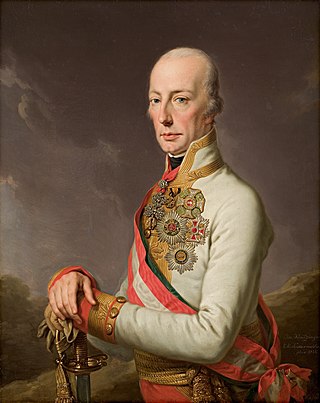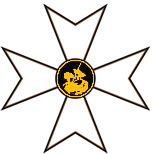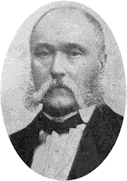
Francis II or I was the last Holy Roman Emperor as Francis II, and the founder and Emperor of the Austrian Empire as Francis I. He assumed the title of Emperor of Austria in response to the coronation of Napoleon as Emperor of the French. Soon after Napoleon created the Confederation of the Rhine, Francis abdicated as Holy Roman Emperor. He was King of Hungary, Croatia and Bohemia. He also served as the first president of the German Confederation following its establishment in 1815.

The Teutonic Order is a Catholic religious institution founded as a military society c. 1190 in Acre, Kingdom of Jerusalem. The Order of Brothers of the German House of Saint Mary in Jerusalem was formed to aid Christians on their pilgrimages to the Holy Land and to establish hospitals. Its members have commonly been known as the Teutonic Knights, having a small voluntary and mercenary military membership, serving as a crusading military order for the protection of Christians in the Holy Land and the Baltics during the Middle Ages.

Owls are birds from the order Strigiformes, which includes over 200 species of mostly solitary and nocturnal birds of prey typified by an upright stance, a large, broad head, binocular vision, binaural hearing, sharp talons, and feathers adapted for silent flight. Exceptions include the diurnal northern hawk-owl and the gregarious burrowing owl.

The national flag of Germany is a tricolour consisting of three equal horizontal bands displaying the national colours of Germany: black, red, and gold. The flag was first sighted in 1848 in the German Confederation. It was officially adopted as the national flag of the German Reich from 1919 to 1933, and has been in use since its reintroduction in Federal Republic of Germany in 1949.

Theobald Theodor Friedrich Alfred von Bethmann Hollweg was a German politician who was Chancellor of the German Empire from 1909 to 1917. He oversaw the German entry into World War I and played a key role during its first three years. He was replaced as chancellor in July of 1917 due in large part to opposition to his moderate policies by leaders in the military.

The American horned owls and the Old World eagle-owls make up the genus Bubo, at least as traditionally described. The genus name Bubo is Latin for owl.

The Eurasian eagle-owl is a species of eagle-owl that resides in much of Eurasia. It is also called the Uhu and it is occasionally abbreviated to just the eagle-owl in Europe. It is one of the largest species of owl, and females can grow to a total length of 75 cm (30 in), with a wingspan of 188 cm, with males being slightly smaller. This bird has distinctive ear tufts, with upper parts that are mottled with darker blackish colouring and tawny. The wings and tail are barred. The underparts are a variably hued buff, streaked with darker colouring. The facial disc is not very defined and the orange eyes are distinctive.
Führer is a German word meaning "leader" or "guide". As a political title, it is strongly associated with the Nazi dictator Adolf Hitler, who officially styled himself der Führer und Reichskanzler after the death of President Paul von Hindenburg and the subsequent merger of the offices of Reichspräsident and Reichskanzler.

Neuschwanstein Castle is a 19th-century historicist palace on a rugged hill above the village of Hohenschwangau near Füssen in southwest Bavaria, Germany, near the border with Austria. The palace was commissioned by King Ludwig II of Bavaria as a retreat and in honour of composer Richard Wagner. Ludwig chose to pay for the palace out of his personal fortune and by means of extensive borrowing, rather than Bavarian public funds. Construction began in 1869, but was never fully completed.
Karl Maria Wiligut was an Austrian occultist and SS-Brigadeführer.
This is a list of words, terms, concepts and slogans of Nazi Germany used in the historiography covering the Nazi regime. Some words were coined by Adolf Hitler and other Nazi Party members. Other words and concepts were borrowed and appropriated, and other terms were already in use during the Weimar Republic. Finally, some are taken from Germany's cultural tradition.

The Deutsche Reichsbahn, also known as the German National Railway, the German State Railway, German Reich Railway, and the German Imperial Railway, was the German national railway system created after the end of World War I from the regional railways of the individual states of the German Empire. The Deutsche Reichsbahn has been described as "the largest enterprise in the capitalist world in the years between 1920 and 1932"; nevertheless its importance "arises primarily from the fact that the Reichsbahn was at the center of events in a period of great turmoil in German history".
The German name of Austria, Österreich, derives from the Old High German word Ostarrîchi "eastern realm", recorded in the so-called Ostarrîchi Document of 996, applied to the Margraviate of Austria, a march, or borderland, of the Duchy of Bavaria created in 976. The name is seemingly comparable to Austrasia, the early middle age term for the "eastern lands" of Francia, as known from the written records.

Rothenburg ob der Tauber is a town in the district of Ansbach of Mittelfranken, the Franconia region of Bavaria, Germany. It is well known for its well-preserved medieval old town, a destination for tourists from around the world. It is part of the popular Romantic Road through southern Germany. Today it is one of only three towns in Germany that still have completely intact city walls, the other two being Nördlingen and Dinkelsbühl, both also in Bavaria.

A district is a second-level division of the executive arm of the Austrian government. District offices are the primary point of contact between resident and state for most acts of government that exceed municipal purview: marriage licenses, driver licenses, passports, assembly permits, hunting permits, or dealings with public health officers for example all involve interaction with the district administrative authority.
The German nobility and royalty were status groups of the medieval society in Central Europe, which enjoyed certain privileges relative to other people under the laws and customs in the German-speaking area, until the beginning of the 20th century. Historically, German entities that recognized or conferred nobility included the Holy Roman Empire (962–1806), the German Confederation (1814–1866) and the German Empire (1871–1918). Chancellor Otto von Bismarck in the German Empire had a policy of expanding his political base by ennobling rich businessmen who had no noble ancestors. The nobility flourished during the dramatic industrialization and urbanization of Germany after 1850. Landowners modernized their estates, and oriented their business to an international market. Many younger sons were positioned in the rapidly growing national and regional bureaucracies, as well as in the military. They acquired not only the technical skills but the necessary education in high prestige German universities that facilitated their success. Many became political leaders of new reform organizations such as agrarian leagues, and pressure groups. Catholic nobility played a major role in the new Centre party, while Protestant nobles were especially active in the Conservative party.

Because of Germany's long history before 1871 as a non-united region of distinct tribes and states, there are many widely varying names of Germany in different languages, more so than for any other European nation. For example, in the German language, the country is known as Deutschland from the Old High German diutisc, in Persian as ‘’Alman’’ (آلمان), in Arabic as Almania (ألمانيا), in Spanish as Alemania and in French as Allemagne from the name of the Alamanni tribe, in Italian as Germania from the Latin Germania, in Polish as Niemcy from the Proto-Slavic nemets, and in Finnish and Estonian as Saksa and Saksamaa respectively from the name of the Saxon tribe.

Bergfried is a tall tower that is typically found in castles of the Middle Ages in German-speaking countries and in countries under German influence. Friar describes it as a "free-standing, fighting-tower". Its defensive function is to some extent similar to that of a keep in English or French castles. However, the characteristic difference between a bergfried and a keep is that a bergfried was typically not designed for permanent habitation.

The Route of Megalithic Culture was first created as a tourist route that meanders from Osnabrück to Oldenburg in North-West Germany. Signposted with brown road signs it links many places of archaeological interest from the Megalithic era.

The Order of St. George – a European Order of the House of Habsburg-Lorraine, or simply Order of Saint George, is a dynastic order of chivalry and thus a house order of the House of Habsburg, the former Imperial and Royal House of the Holy Roman Empire, the Habsburg monarchy, the Empire of Austria, the Austro-Hungarian Monarchy, the Kingdom of Hungary, the Crown lands of Bohemia and Croatia and further nations.















